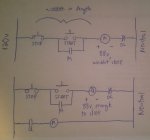All,
This really isn't a question, but just something I learned today at work (I'm relatively new to the industry, so I'm learning something every day). I inherited a new MCC room from my predecessor who left the company, and the motors I just recently re-feed are a good distance away from the MCC room. It turns out that the start/stop wires are so long in length, that there's a considerable voltage drop (16 awg wire), so much so in fact that there's not enough voltage to pull in the contactor. What we did was add in a 120v relay (which can close with less than 120v), and then have the relay control the 120v going to the contactor. Nifty trick.
Lesson learned: the bigger the control wires the better (within reason of course)
This really isn't a question, but just something I learned today at work (I'm relatively new to the industry, so I'm learning something every day). I inherited a new MCC room from my predecessor who left the company, and the motors I just recently re-feed are a good distance away from the MCC room. It turns out that the start/stop wires are so long in length, that there's a considerable voltage drop (16 awg wire), so much so in fact that there's not enough voltage to pull in the contactor. What we did was add in a 120v relay (which can close with less than 120v), and then have the relay control the 120v going to the contactor. Nifty trick.
Lesson learned: the bigger the control wires the better (within reason of course)




